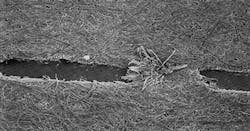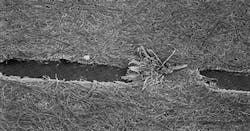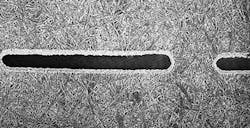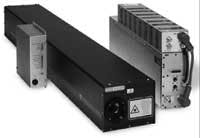Perf-ect form
Paper forms are such an integral part of business that, despite the advent of computers and the Internet, commerce would be far more difficult without forms on which to print RFQs, estimates, orders, bills, pay checks and all the other documents used by modern businesses. In turn, manufacturing perforated forms would be considerably more difficult and time consuming for the paper-converting industry without the use of highly reliable sealed carbon dioxide (CO2) lasers.
Business forms of all types are perforated to enable portions or copies of documents to be separated (by tearing) and retained by users. Before the use of lasers, perforations were created by mechanical wheels that would punch holes in the paper forms as they were being printed. This method was messy, hard to control and would create inconsistent perforations. Today, converters laser-perforate either across or along the length of the paper, then ship the paper to printers to print the forms.
Traditional mechanical perforating
Before switching to laser perforating, converters used mechanical rotary wheels to perforate paper. As Charles Pingel, project engineer at Appleton Papers, Appleton WI, recalls, "Mechanical wheels invariably left fibrous debris in the holes they created as well as fiber dust on the finished forms. This residue reduced print quality and necessitated frequent cleaning of printing presses." Moreover, mechanical wheels would cause damage to paper fibers in the space between perforations (called lands) and weaken the sheet (see Figure 1). These burrs and fibers often compromised runability on printing presses, causing jams and contaminating ink fountain solutions.
Laser perforating
Laser perforating was a giant leap forward for the converting industry. By switching to lasers, the paper converting industry has eliminated the problems associated with mechanical perforating methods.
Pulsed sealed CO2 lasers are an ideal choice for this application for several reasons. First, their variable high-frequency (up to 100 kHz) infrared wavelength (10.6 micron) output pulses have fast rise- and fall-times relative to the duration of the pulse. Fast rise- and fall-times mean that energy is efficiently delivered for cutting or drilling, rather than for merely heating the material to be processed. The result is a clean perforation, with no fiber debris in the perforated hole, no fiber dust and no damage to landing areas (see Figure 2). Consequently, laser-perforated paper can run on printing presses without jams or contamination, and without compromising print quality.
By controlling pulsewidth, pulse frequency and duty cycle, the amount and rate at which energy is delivered by a sealed CO2 laser can be accurately adjusted. Consequently, a "soft-tooling" approach can be used, whereby a single sealed laser is used for a variety of converting applications by switching between preset laser parameters. Pingel reports, "Some customers want scored paper rather than perforated paper." Scoring requires that a shallow trough be cut into the paper without cutting all the way through the sheet. "Switching from perforating to scoring on the same laser workstation is easy with sealed lasers. We simply adjust the laser parameters to pre-determined settings and start scoring," adds Pingel.
The non-contact nature of laser processing is another advantage of this technology over mechanical methods. According to Pingel, tool wear used to cause problems for converters, "Over time, as the mechanical wheels wore down, the quality of the perforations would degrade and their tear strength would change. So, the wheels had to be replaced regularly, which increased downtime and lowered productivity." By contrast, as a zero-wear tool, the laser creates the same high-quality hole repeatedly and consistently, with no need for tooling replacement.
One of the most important features of sealed lasers for converters is the high-reliability of their no-maintenance design. Because sealed lasers such as the Diamond from Coherent Inc. (Santa Clara, CA) (see Figure 3) are diffusion-cooled, slab-discharge systems, manufacturers claim that they require no replacement gas and no scheduled maintenance to the laser head for up to 25,000 hours of operation. In fact, end-users frequently see far longer operational lifetimes than manufacturers claim (see sidebar). This no-maintenance characteristic coupled with high-reliability directly translates into maximum uptime for converters. Pingel says, "We have six sealed CO2 laser systems ranging from 150 to 250 W, and they just keep running and running, 24 hours a day. In fact, we are about to install our seventh system."
The small size of sealed lasers has also benefited the converting industry. Diffusion cooling allows these lasers to be compact, but without a reduction in output power. For example, a unit capable of producing up to 500 watts of average output power (with 1.5 kW peak power) measures just 11 × 9.5 × 47 inches and weighs only 135 pounds. This means that they require minimal shop floor space and can easily be mounted directly over work surfaces.
Laser micro-perforating
Traditional mechanical methods created perforated slots that were a few millimeters in length with a large area. The large size of these perforations was a direct consequence of the nature of mechanical tooling. Mechanical punching of micro holes is not practical in production quantities because fragile precision dies are prohibitively expensive and their lifetimes are notoriously short. Consequently, mechanically perforated holes/.slots had to be large enough to allow efficient manufacturing.
Converters began to take advantage of the small focal spot size of lasers to create smaller holes that were more closely spaced (smaller lands.) The result was micro-perforation, which saves space on the form, provides more consistent tear strength and offers faster processing for converters.
Conclusion
Perforated paper forms are an integral part of modern business. In the quest to manufacture perforated paper more easily, efficiently and economically, converters have adopted laser technology. The unique characteristics of laser processing create far cleaner perforations that eliminate many of the printing problems associated with mechanical perforating. Moreover, the reliability of sealed CO2 lasers allows converters to operate production lines continuously and with a minimum of maintenance downtime, thereby increasing productivity. Furthermore, the non-contact nature of laser processing eliminates costs associated with tool wear and creates far more consistent perforations with uniform tear strength. Lasers also offer the flexibility and economic benefits inherent to a "soft-tooling" approach that will allow converters to more rapidly respond to customer needs while minimizing production costs. Z
Sri Venkat is director of marketing-Materials Processing Business Unit, Coherent Inc., 5100 Patrick Henry Drive, Santa Clara, CA 95054; Tel: (408) 764-4446; fax: (408) 764-4800; e-mail: [email protected]; web site: www.CoherentInc.com.
"...they just keep running and running"
- Charles Pingel
Now that sealed lasers have been available and in the field for approximately a decade, data from industrial end-users indicates that they are far more reliable than laser manufacturers had ever imagined. Major laser manufacturers claim 25,000 hours, or nearly 2.5 years, of continuous maintenance-free operation for sealed CO2 lasers (see figure). However, Appleton Papers' experience was quite different. Appleton Papers installed its first sealed CO2 lasers in 1993 and has operated them continuously (24 hours per day, 7 days per week) ever since then. As Charles Pingel recalls, "When we first got them, we were told to send them back regularly for refurbishment. But when the time came for scheduled maintenance, we didn't see any degradation in performance, so we kept running them. It was close to six years before we sent some of them back with nearly 50,000 hours on them." This reputation for high reliability has helped to make sealed CO2 lasers the industrial workhorse of choice for many applications.
null




